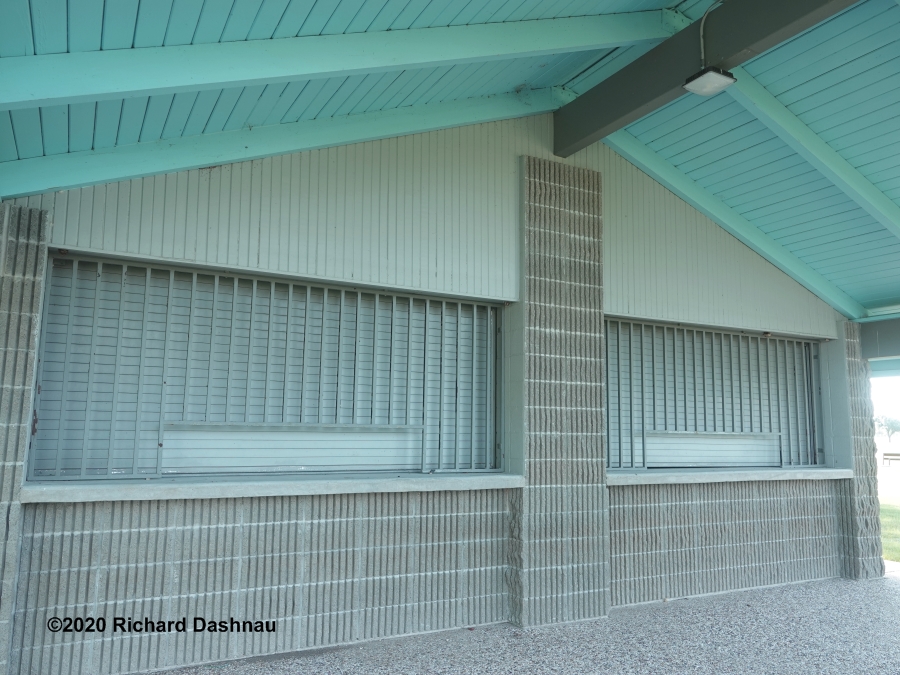
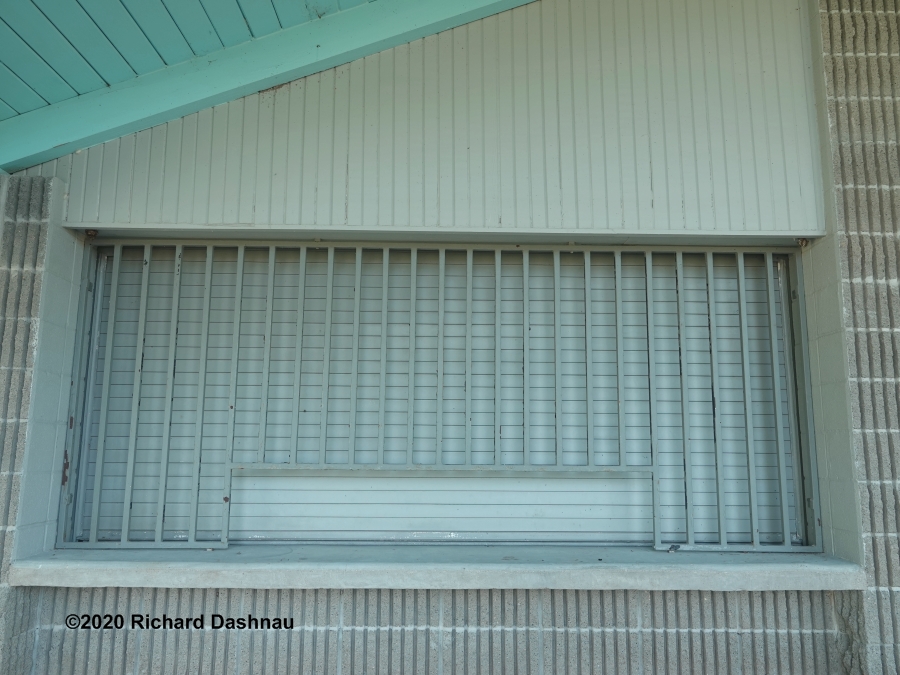
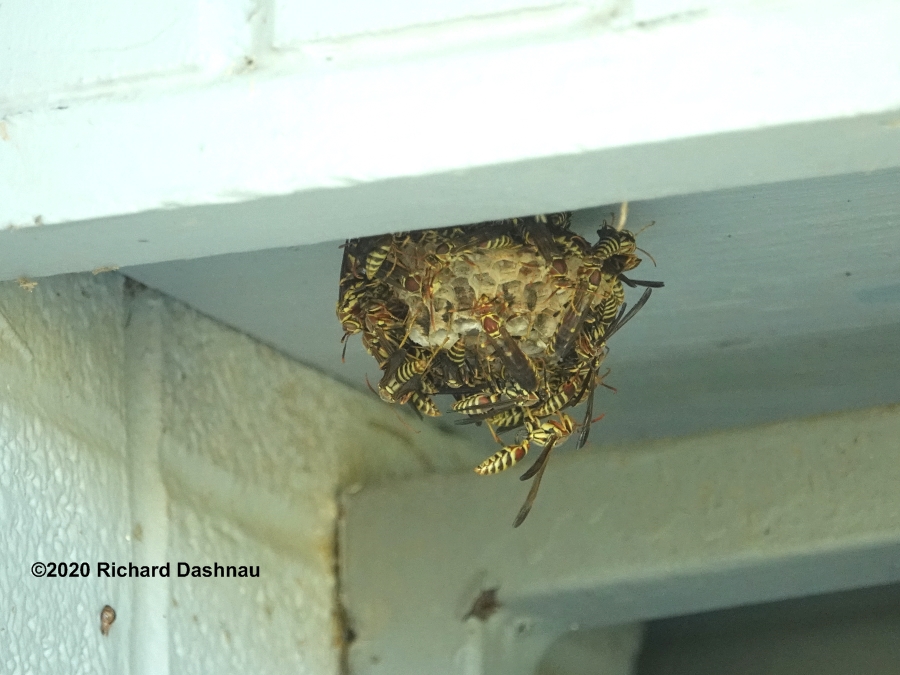
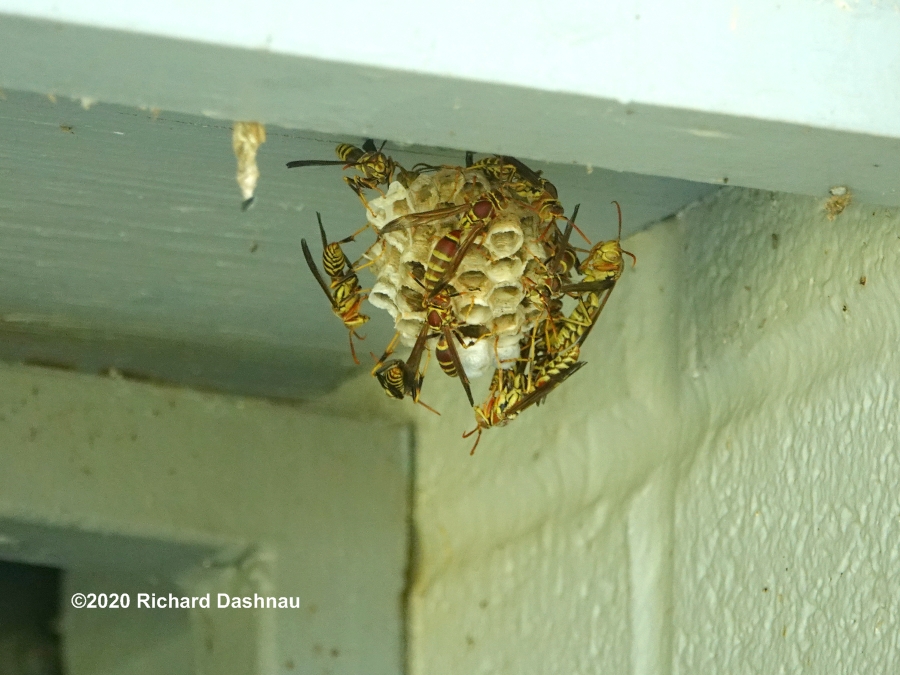
Concession Stand Windows One nest in each corner of Left Window Nest in left corner Nest in Right Corner
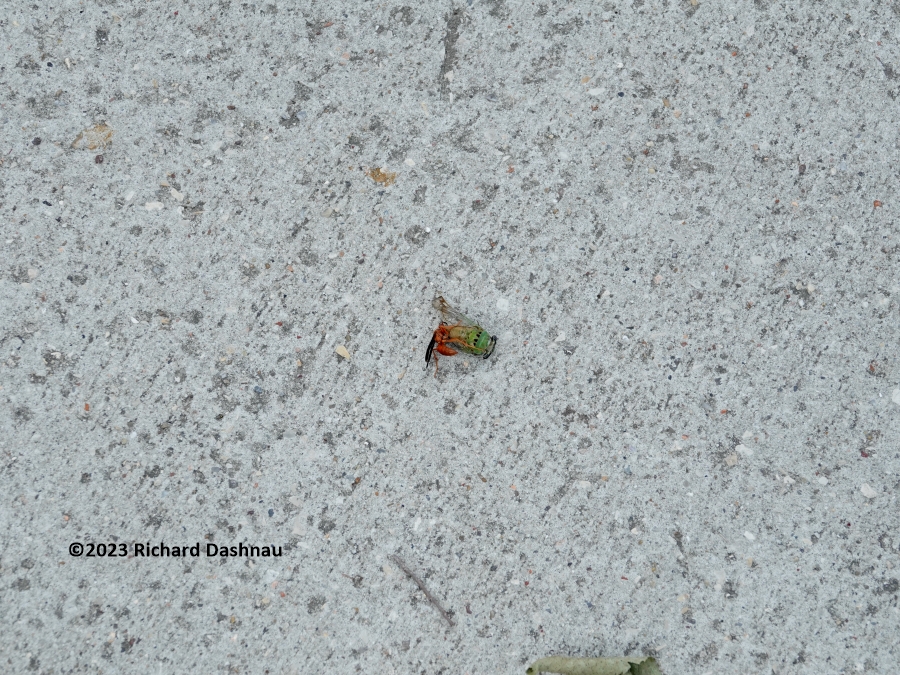
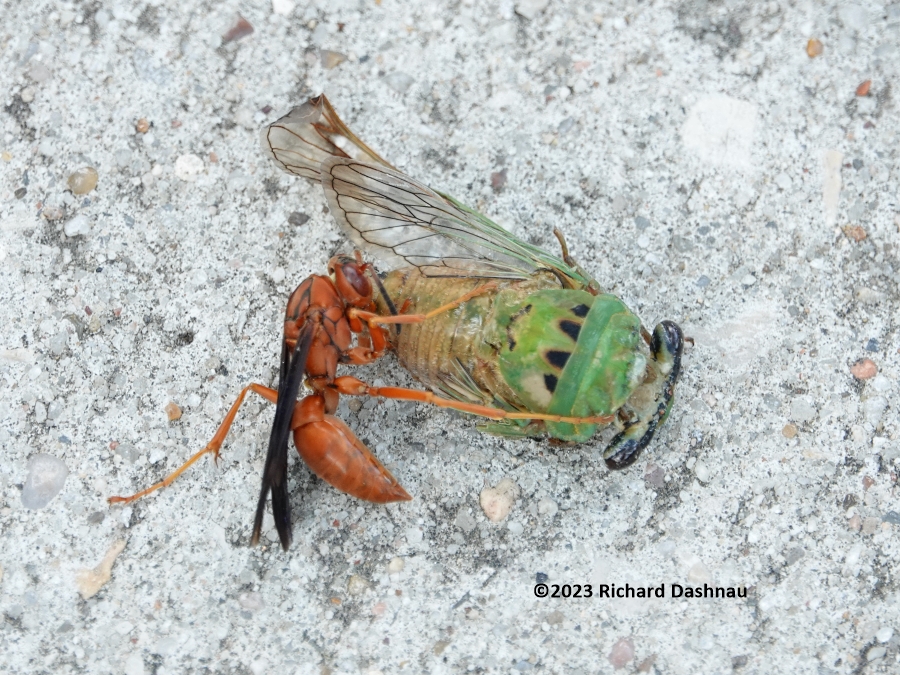
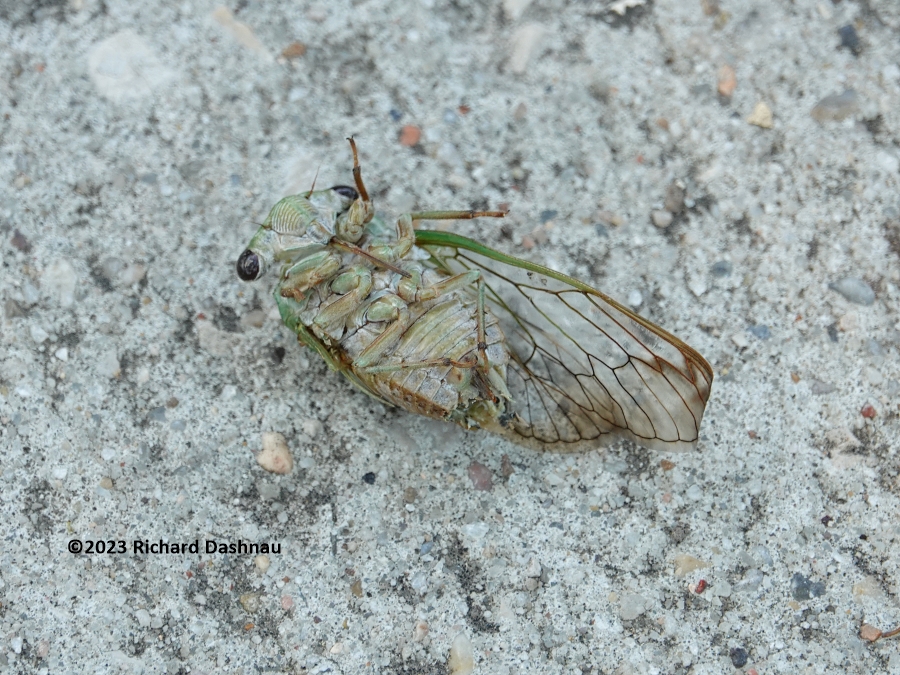
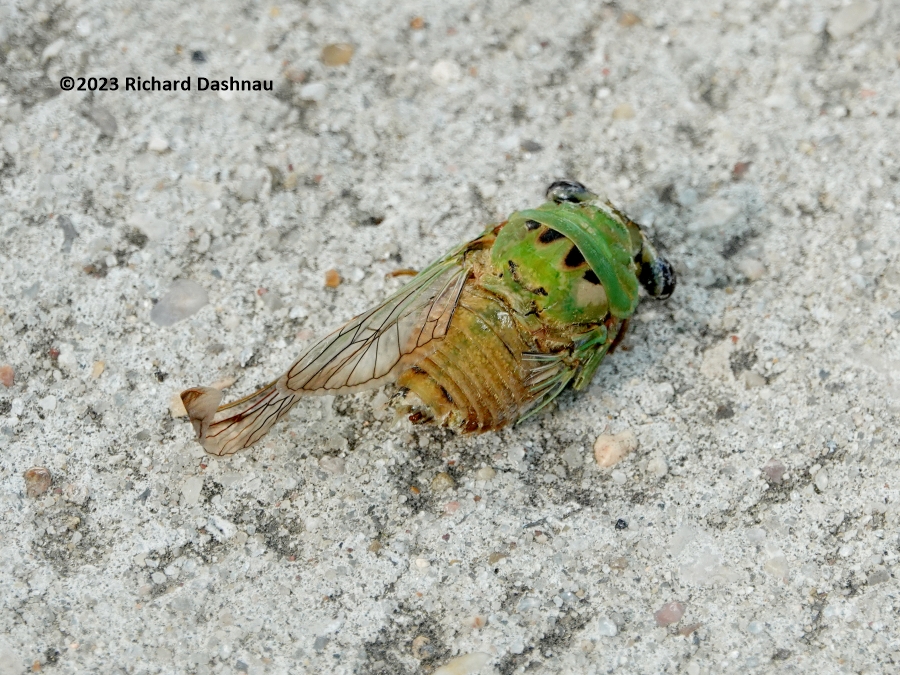
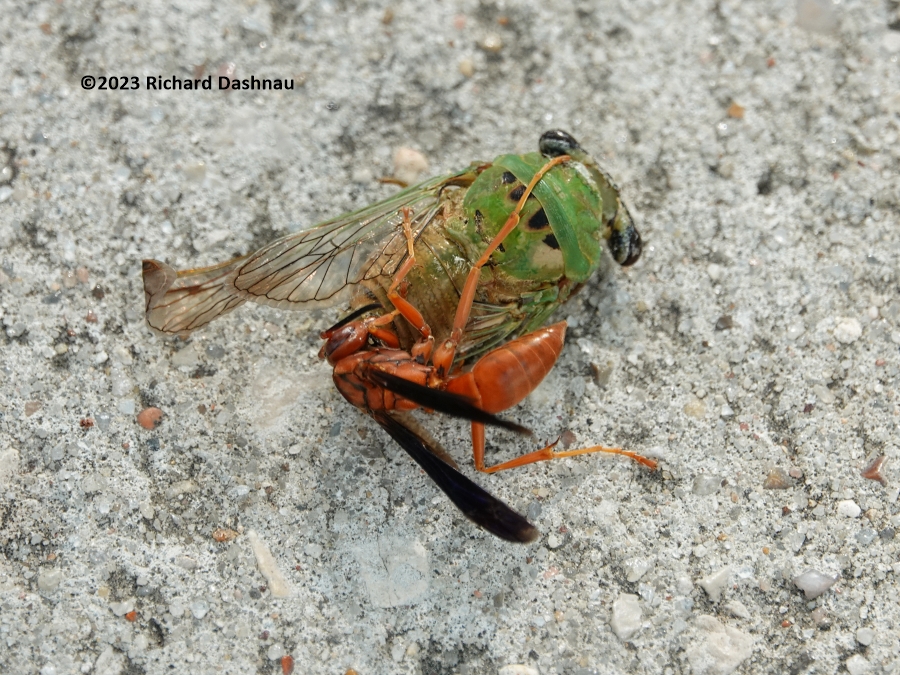
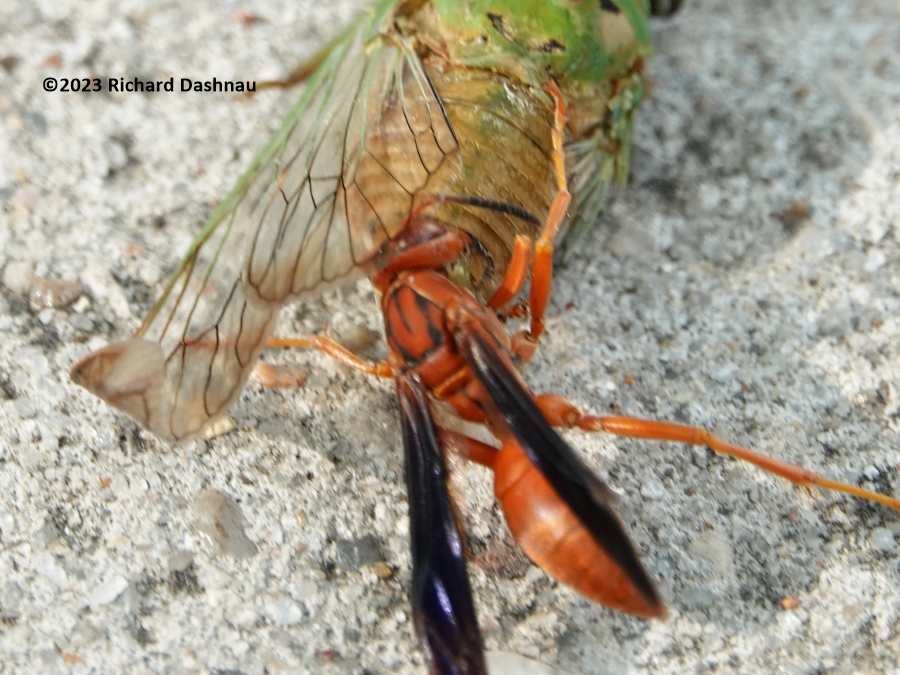
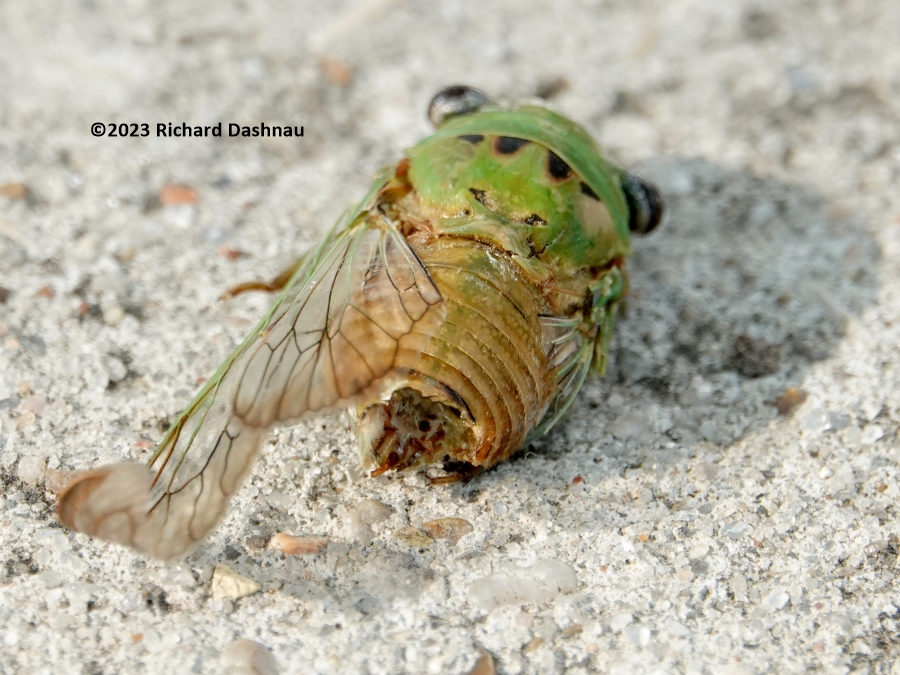
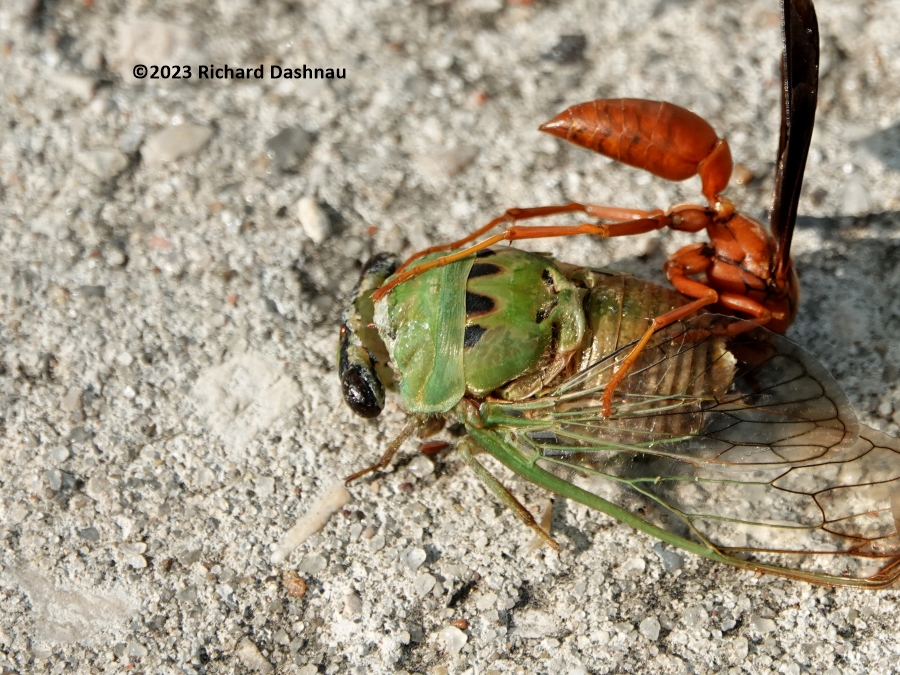
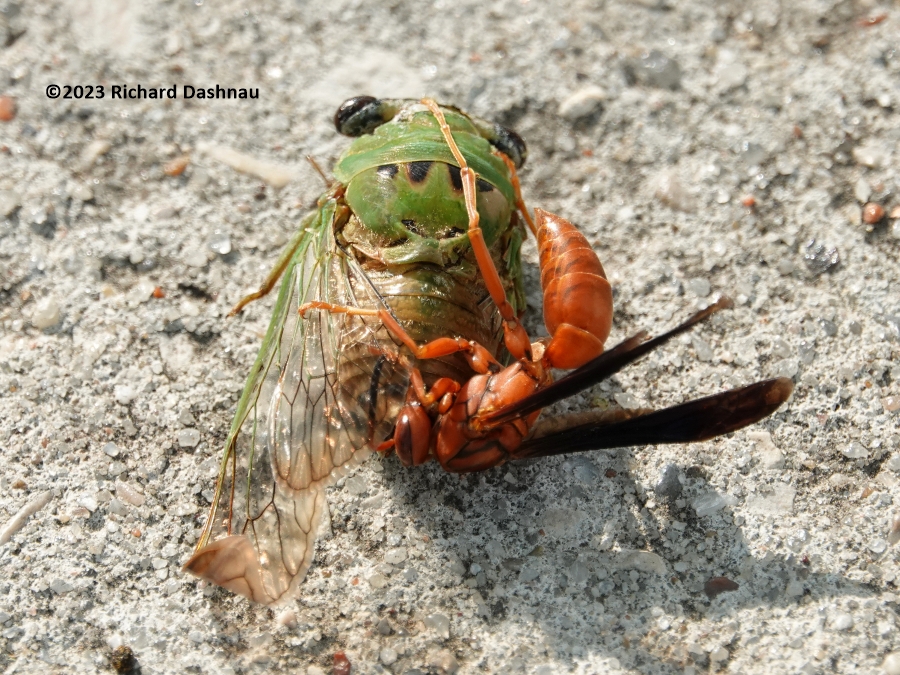
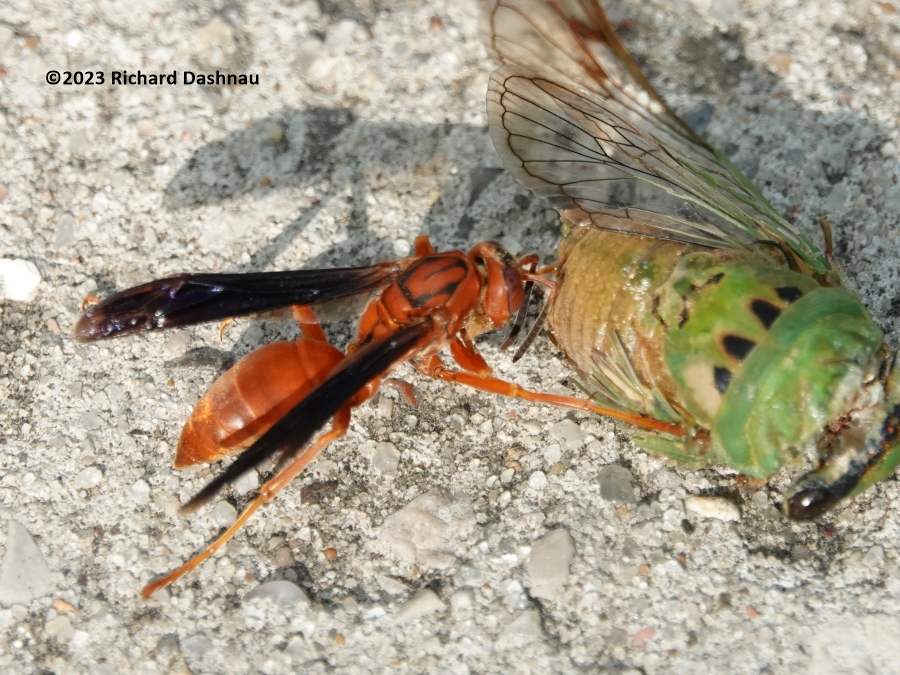
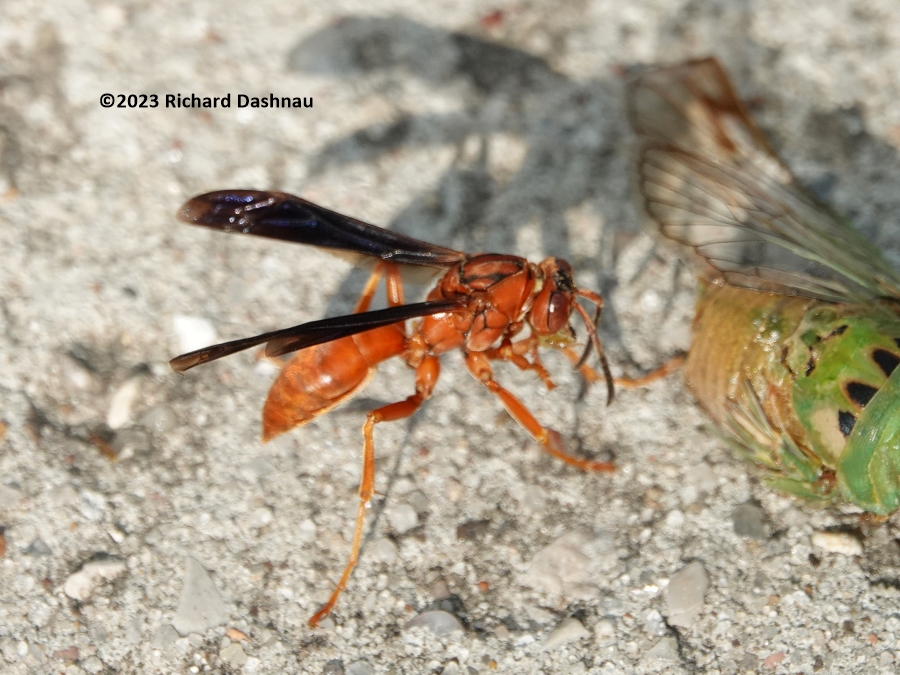
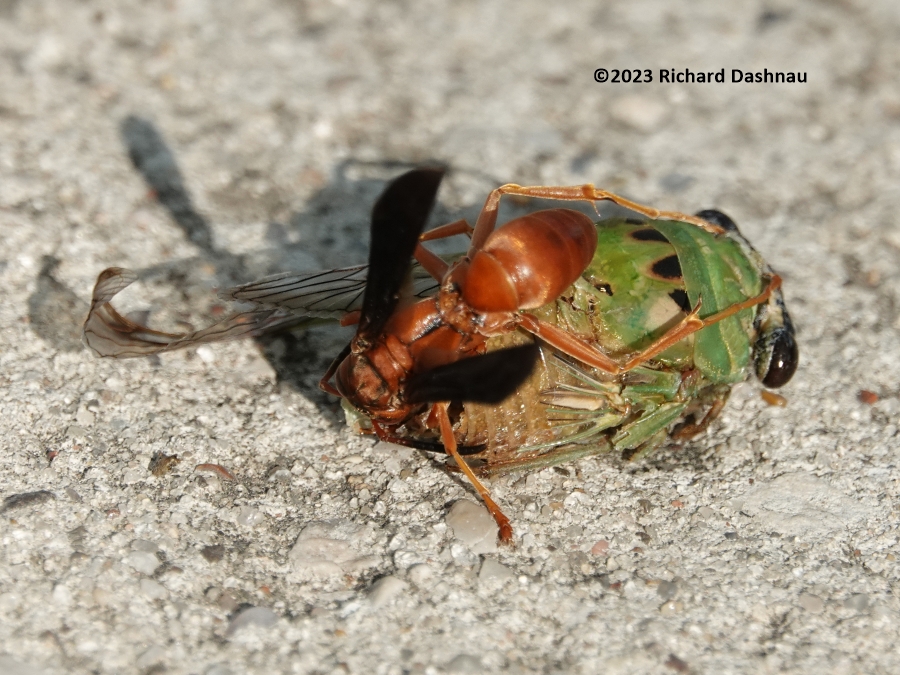
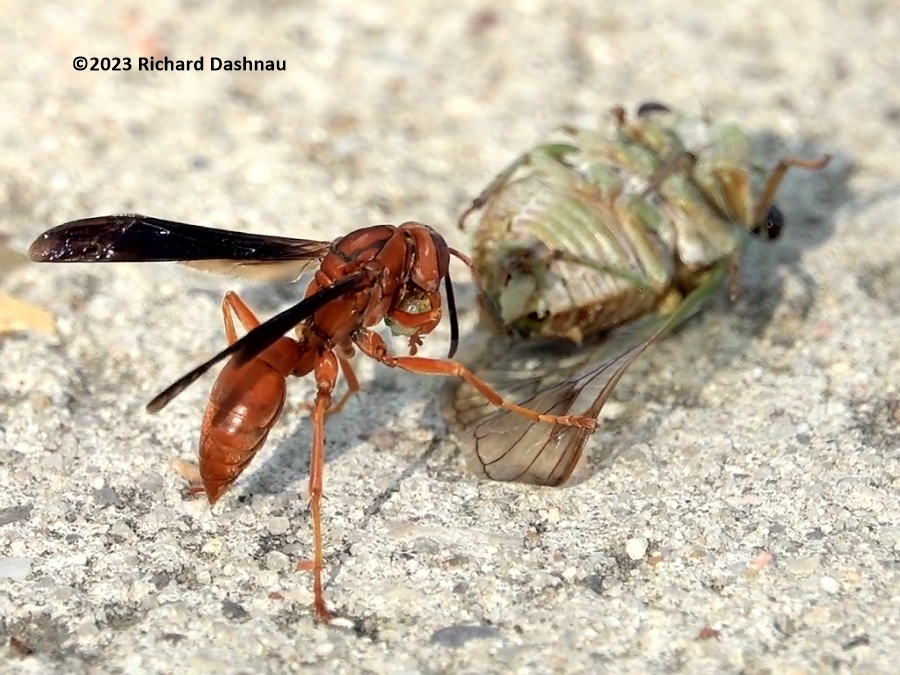
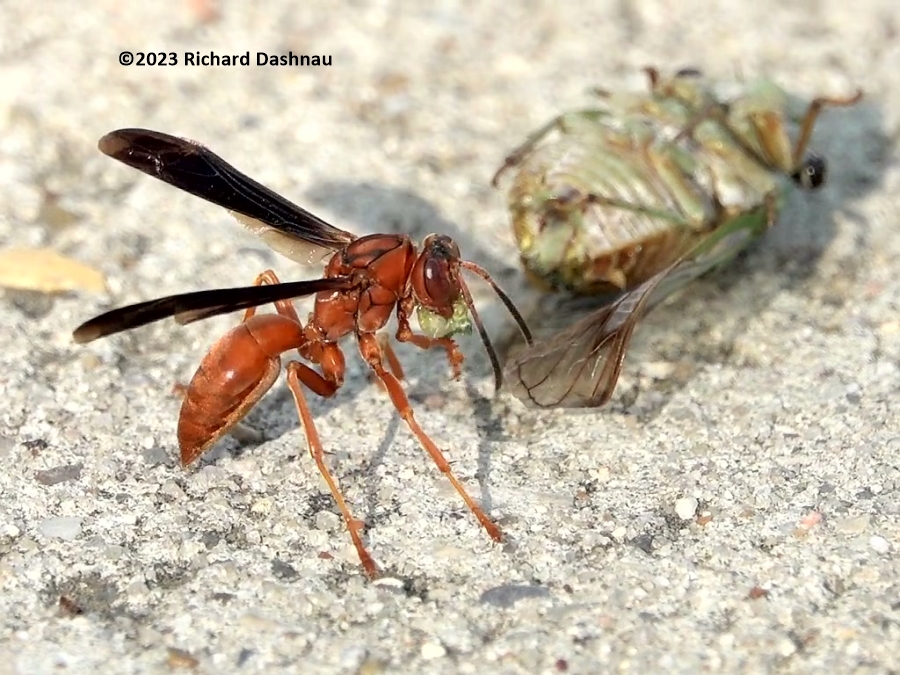
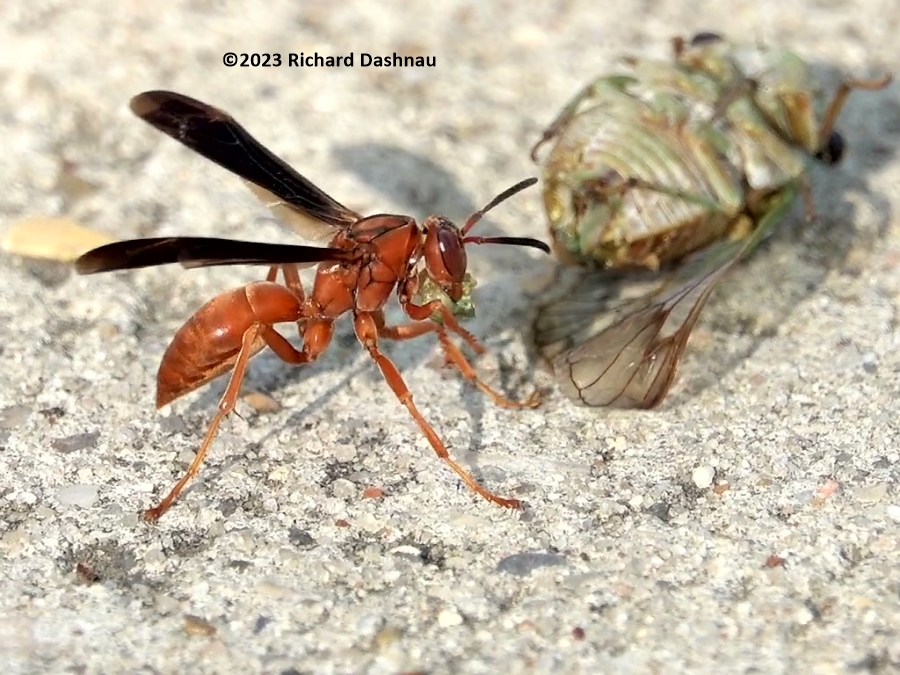
material filmed Sept
13,19,26, 2020 (update 12/13/2020)
Since
I was in the neighborhood n 9/13/2020, I went to Scobee Field
(It's inside George Bush Park) to look for some wasp nesting
behavior.
Fortunately, there weren't many people around, so I could stay for a
while. I found some wasp nests on the Bathroom/Concession
building. They were in a great spot, low and easy to get
good
closeups. In 2018, I'd watched some Polistes nests at Brazos Bend State
park (documented on this page-see 09/30/2018). At that time I witnessed
cannibalism of a wasp
larva by a worker.
I learned back then that this is not uncommon, so I hoped
to witness it again. (I got most of my information from two sources:
the book The Evolution of Social
Wasps, by James H. Hunt;and
Effect of food
availability on larval cannibalism by foundresses of the paper wasp
Polistes chinensis antennalis by K. Kudoˆ • A. Shirai.)
Special Note: The
Polistes wasps in this story have been positively identified as
Polistes exclamans by these
folks on Twitter: Chris Alice Kratzer (@humanbyweight) and
Emilio
Peruzzi S. (@darlingbeetle) THANK YOU!!
I was not happy with the lighting, and I was reluctant to try to use a flash while I was standing so close to the nests. So I left, planning to return the next weekend. These photos are from 9/13/20:




Concession Stand
Windows
One nest in each corner of
Left Window
Nest in left
corner
Nest
in Right Corner
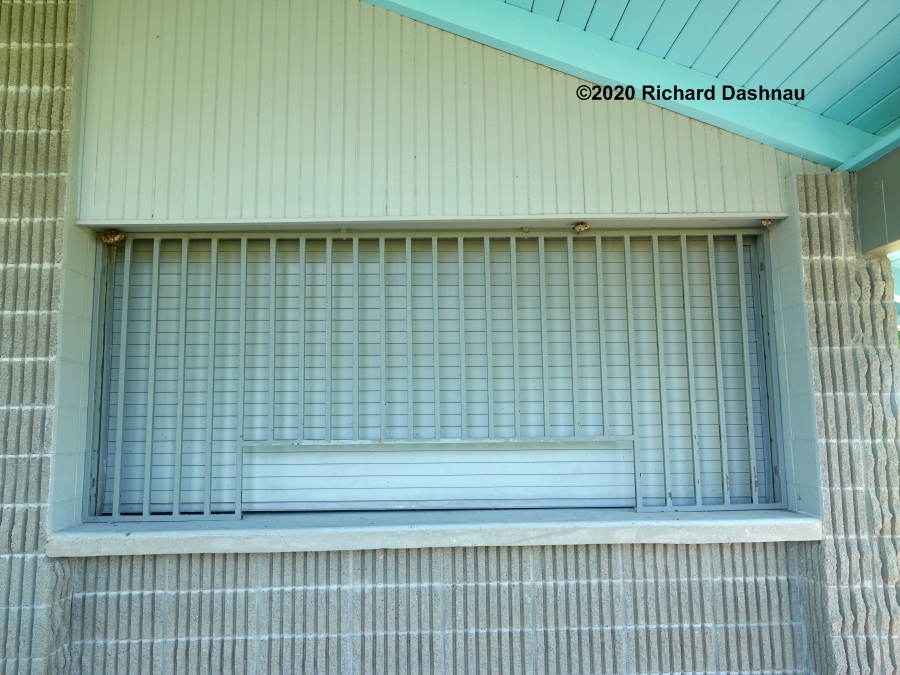
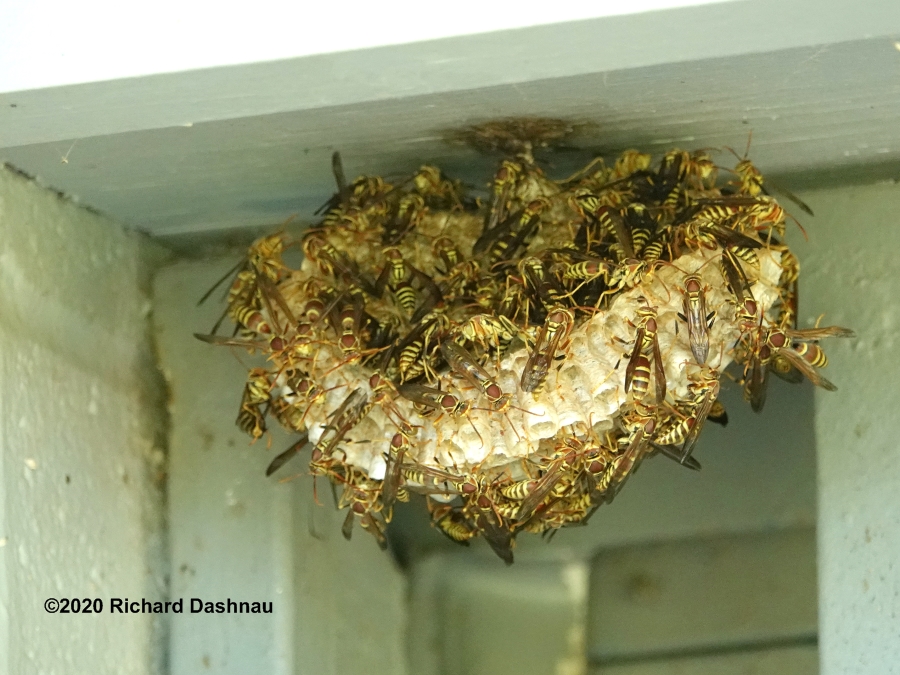
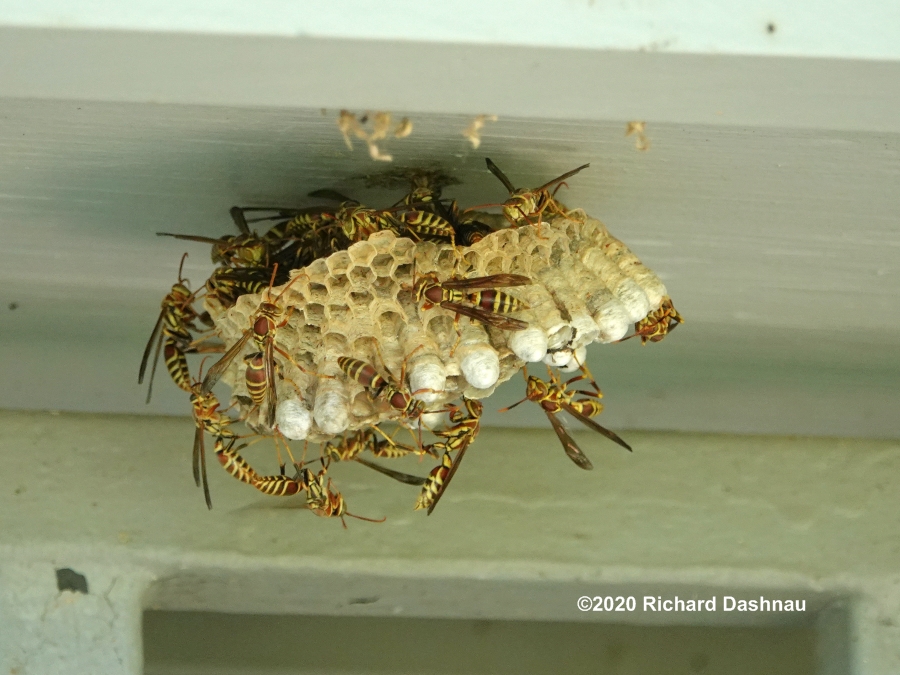
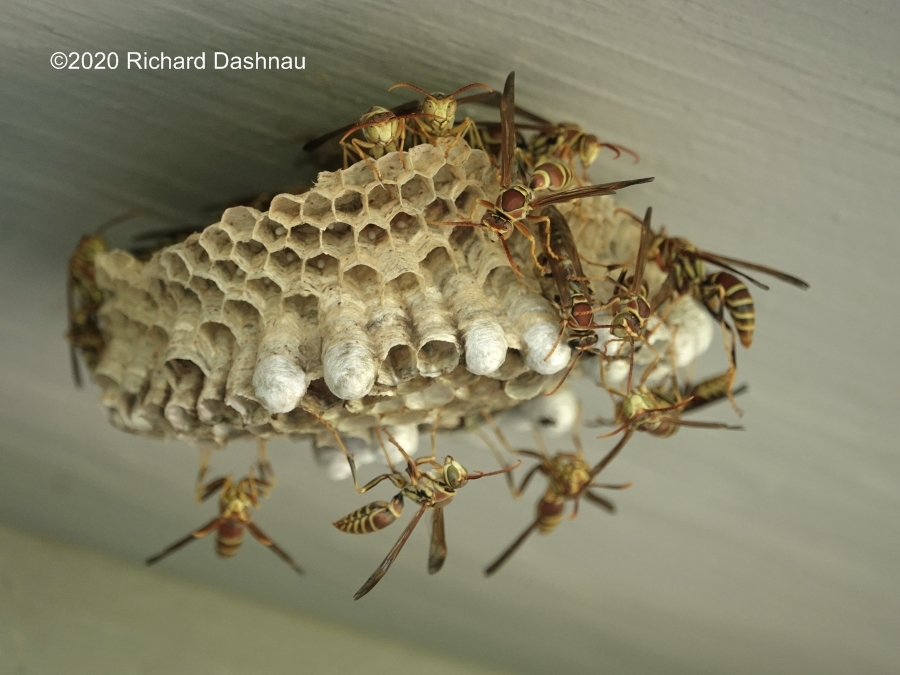
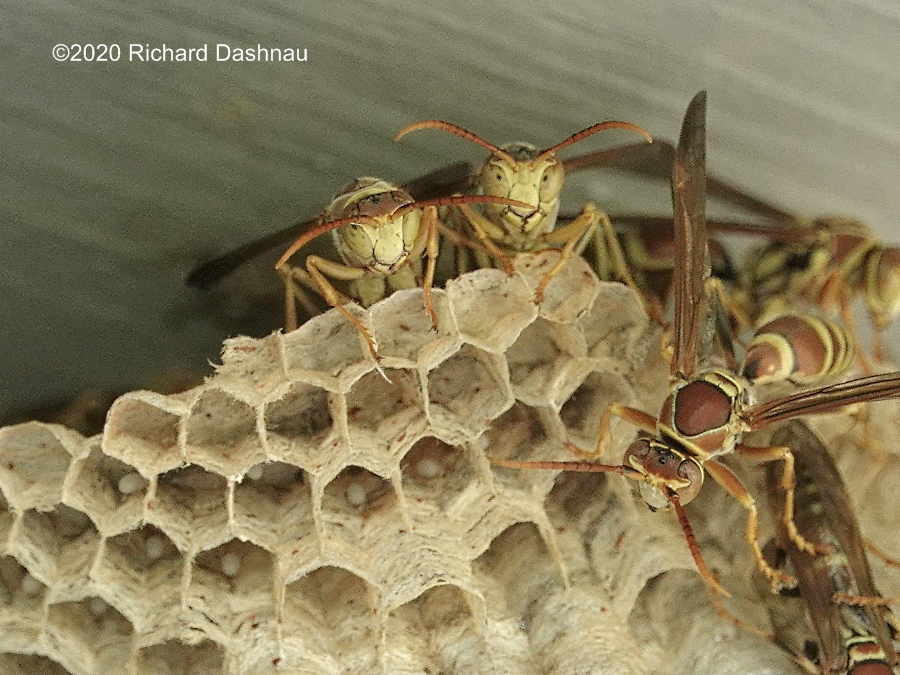
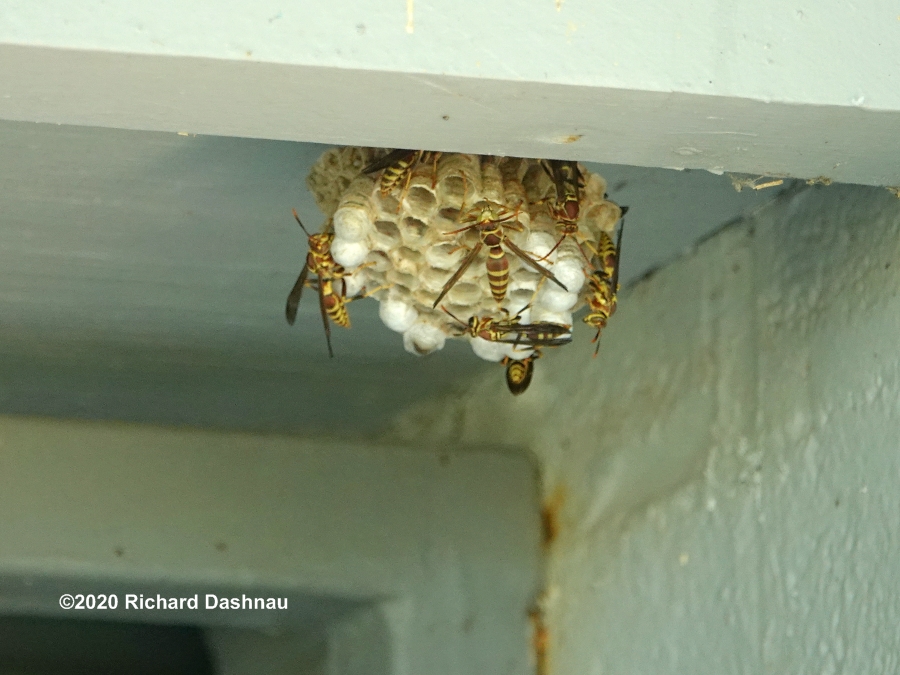
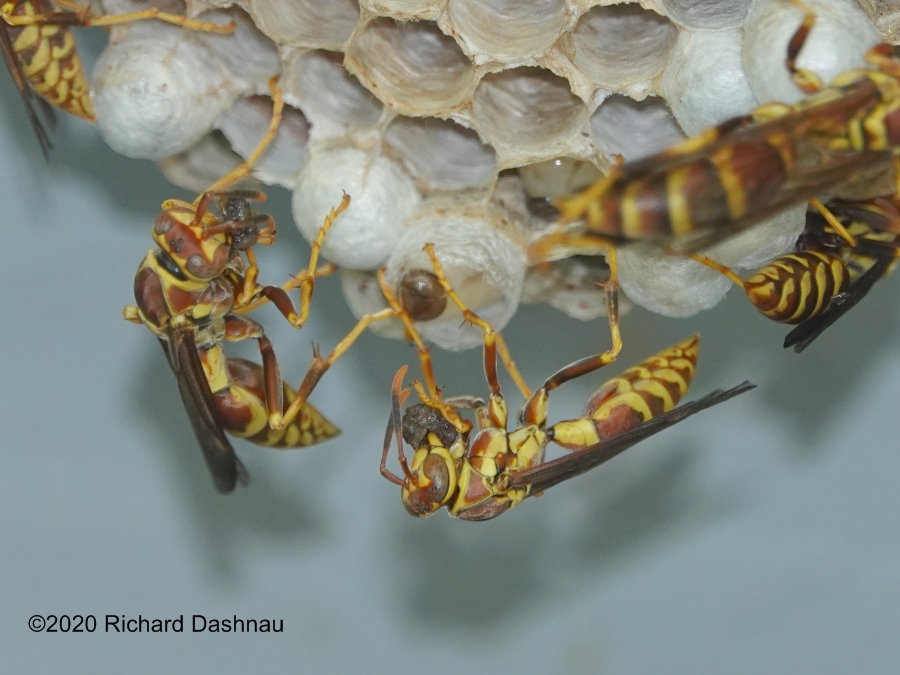
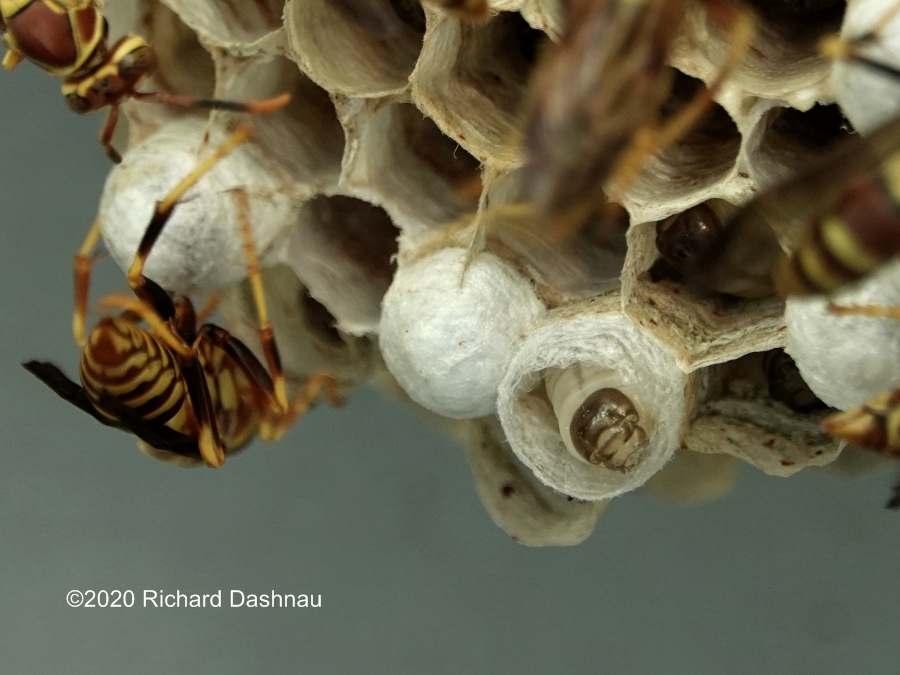
Nest
in Center of
Right Window Closeup
Nest
in Right corner of
Right Window
Right
corner of
Right Window closer
Right
corner of
Right Window even closer
The
first image shows eggs in the cells.
The third image, shows two wasps kneading some prey,
preparing it to feed to the larvae.
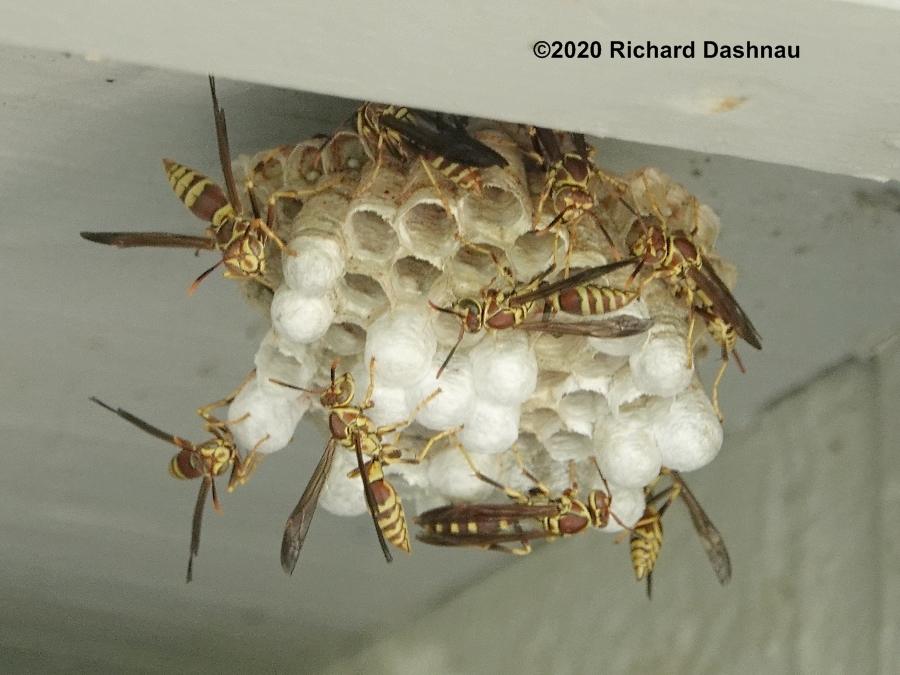
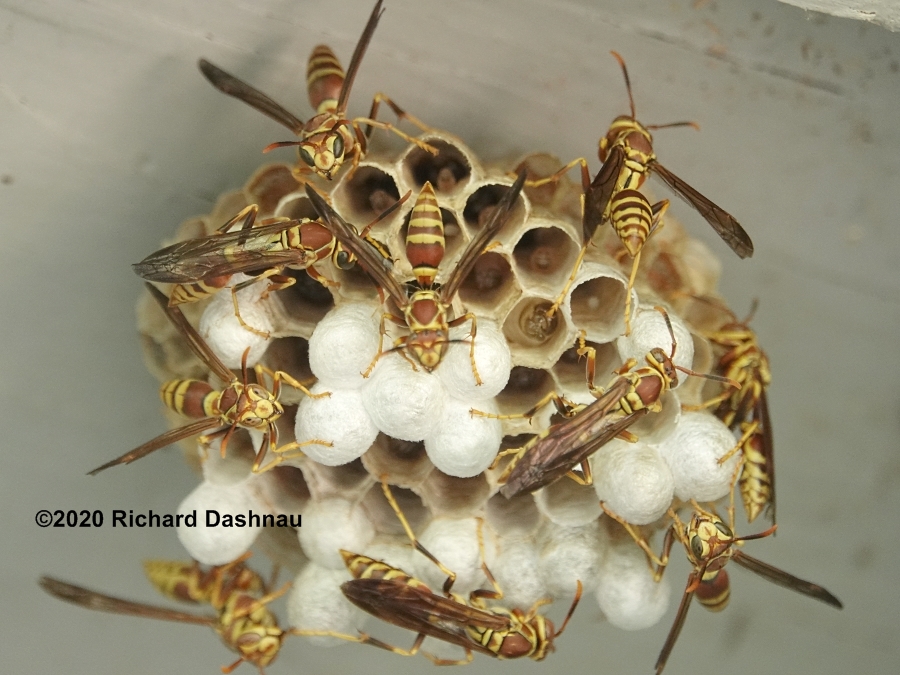
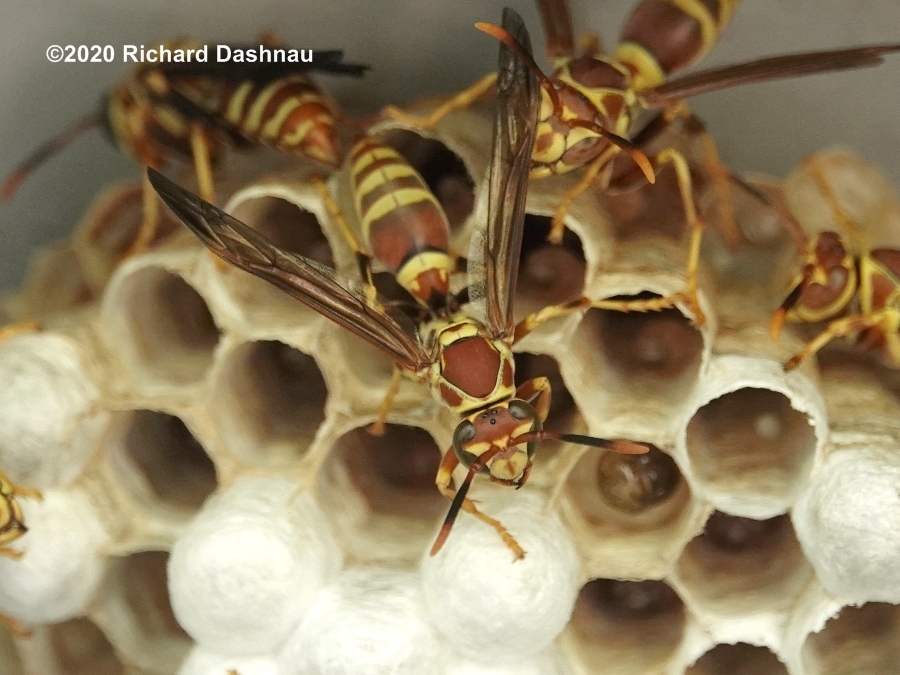
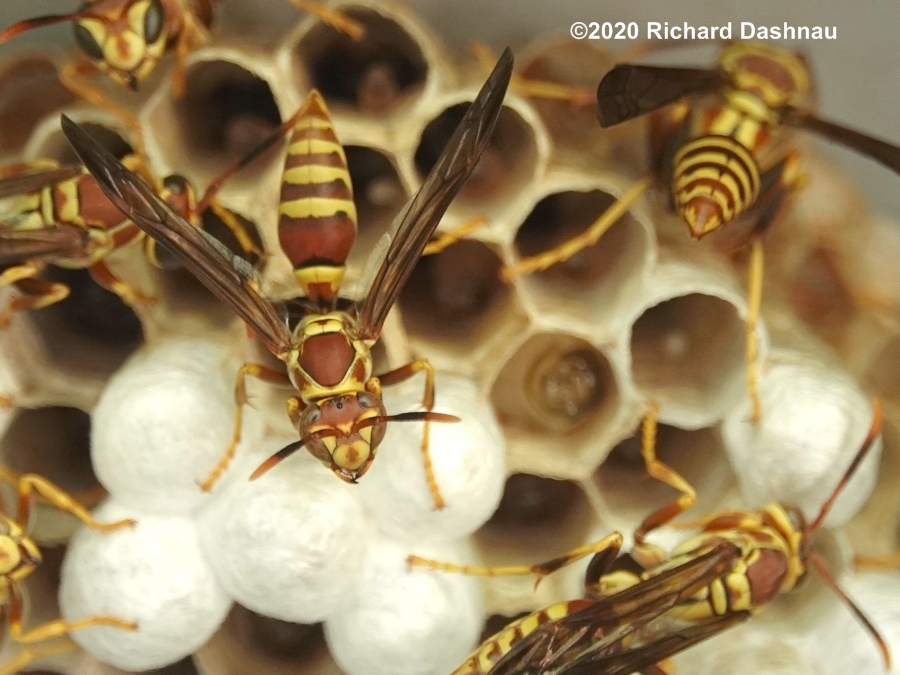
The entire nest is small
Zoom
in a bit closer
Zoomed even
closer, still no
flash.
Notice the eyes
are clearer with angle change
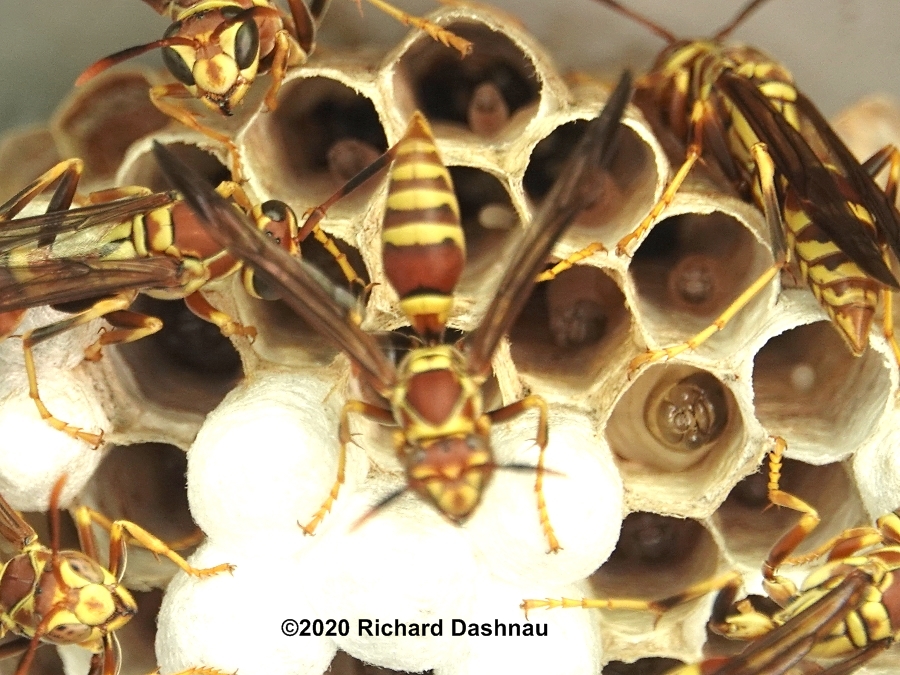
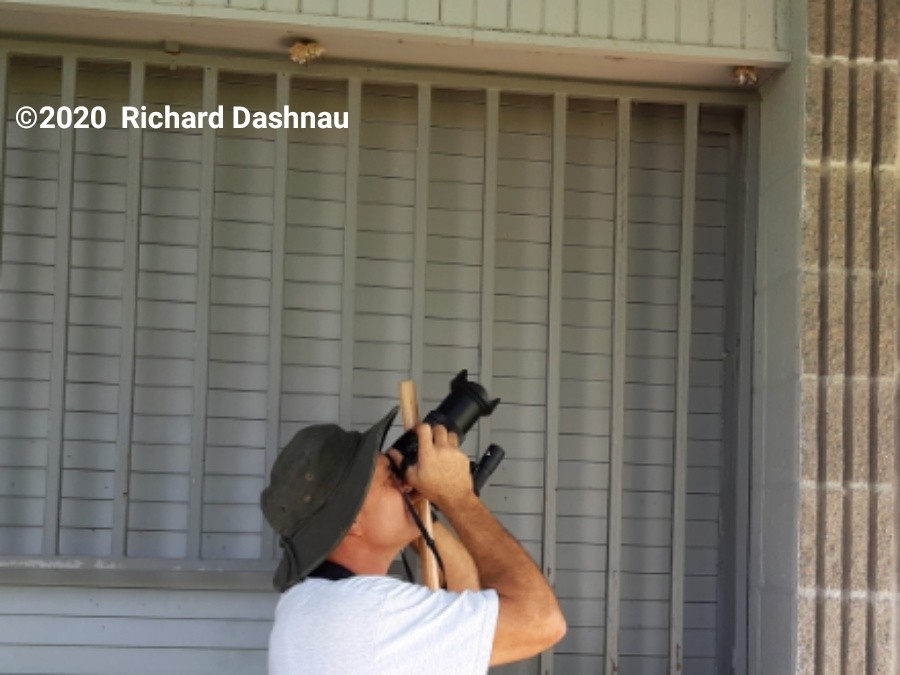
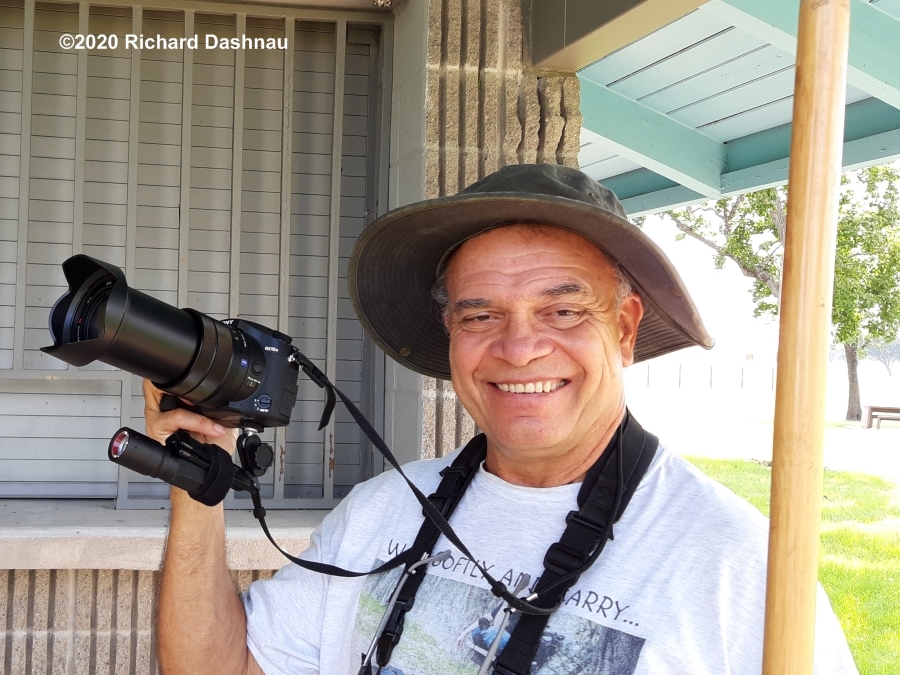
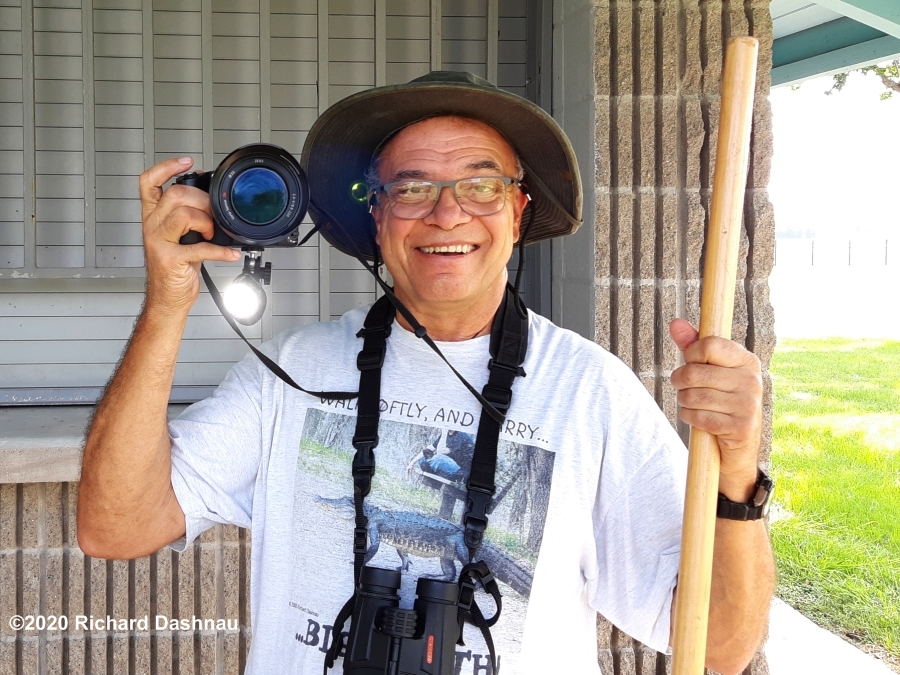
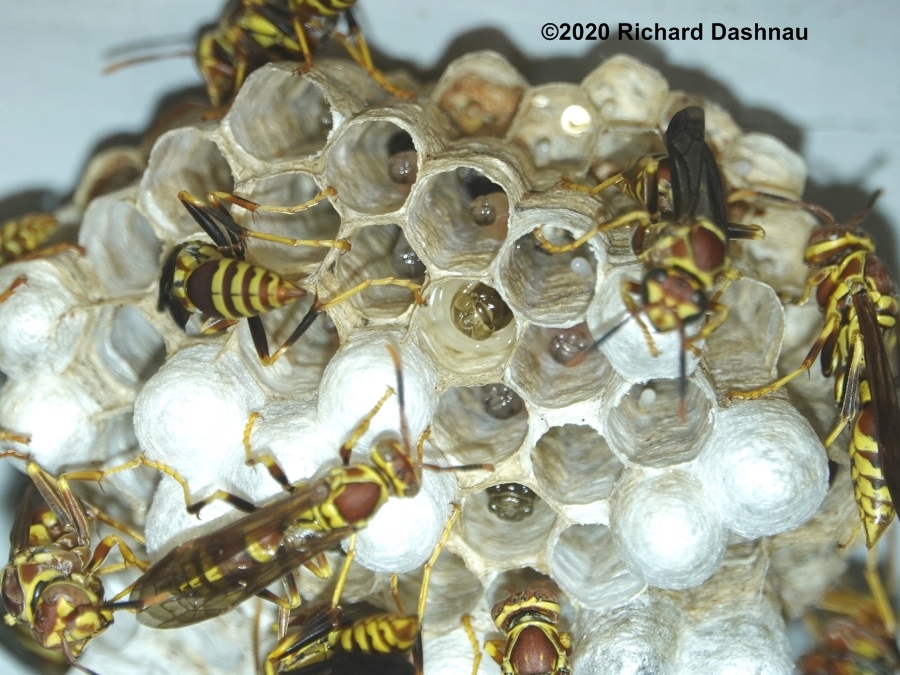
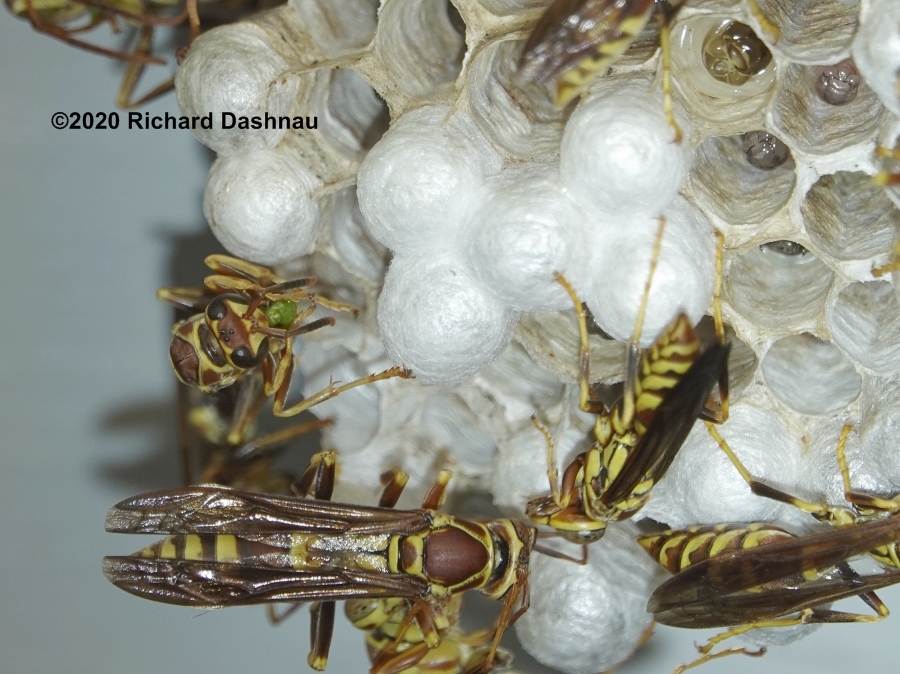
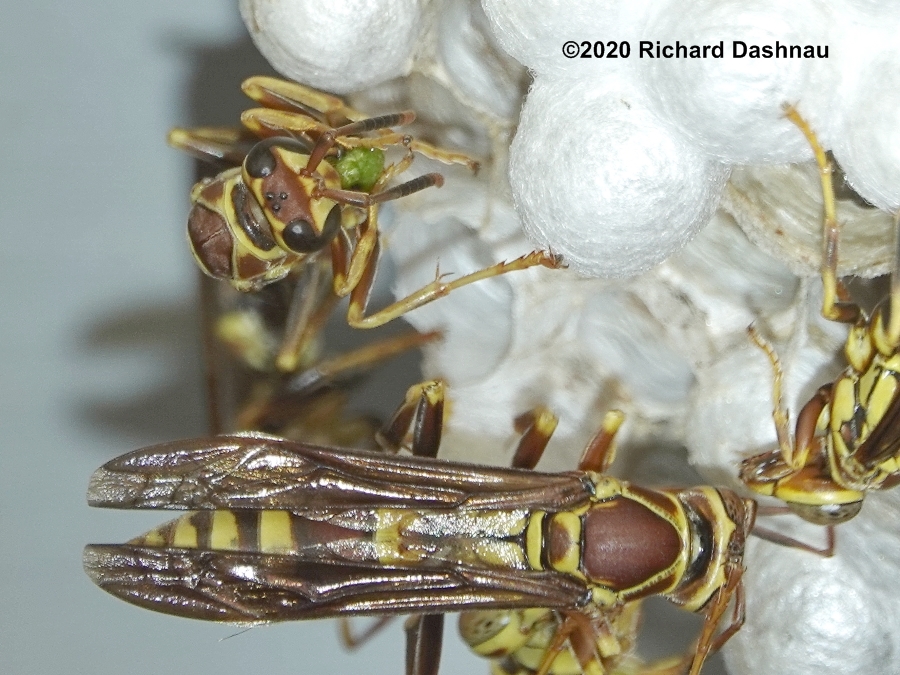
Light shows
eggs and larvae.
Workers
kneading (malaxating) prey (green pods)
Closer
view of workers malaxating.
During
malaxation the solids are rendered to easily-digestible pulp,
while liquids are taken from the mass and stored in the crop of the
wasp. The liquid stored in the crop can
be
regurgitated and fed to
young larvae. As the larva get older and bigger, they are
also
fed sections of the pulped solids. Meanwhile, the adult workers feed on
"leftovers" --skimming
liquids
and solids from the pellets.
Adult workers also get additional nutrition from the older
larvae. If a worker strokes the face and mouthparts of a larva with its
antennae, the larve can produce
"nurtritional saliva" which the workers eat. As
the season progresses, weather gets colder, and eventually
food
sources dwindle. Less prey to malaxate means less food for the larvae,
and
less "extra" for the workers. Less food
for the larvae means
that they can't produce the "saliva", so...no bribes or rewards for the
workers. Hungry workers will then eat the larvae. I've only
seen this
once, and
I was hoping to observe this cannibalism again. I've got
pictures and
link to a video that showed this on this page (see 09/30/2018).
(Reference: THE EVOLUTION OF
SOCIAL WASPS by James H.
Hunt
pages 53 -55)
I
used a flashlight instead of camera flash for two reasons:
1) I'm
concerned the brief, bright flash might trigger movement that a steady
light might not.
2) I also shot video and the flash doesn't work for that.
Here's
the edited video! About 5 minutes long.
One more thing--I always
carry a little Ultrapod with me, and have for years.. It fits easily in
a pocket, is very light, has a handy velcro strap (which I used in this
case to hold the flashlight) and
has a 1/4 inch mounting bolt (which allowed me to attach it to the
camera). I intended to return the next week. I
did return the next week, and was very disappointed to see that the
nests had
been removed. I don't go to Scobee field very often, so I
don't know how often the concession windows are used. With
following Covid control protocol, I wouldn't have been there at all if
there
were people near those windows. But, maybe someone noticed me
looking at the nests. For whatever reason, the wasps are
gone.
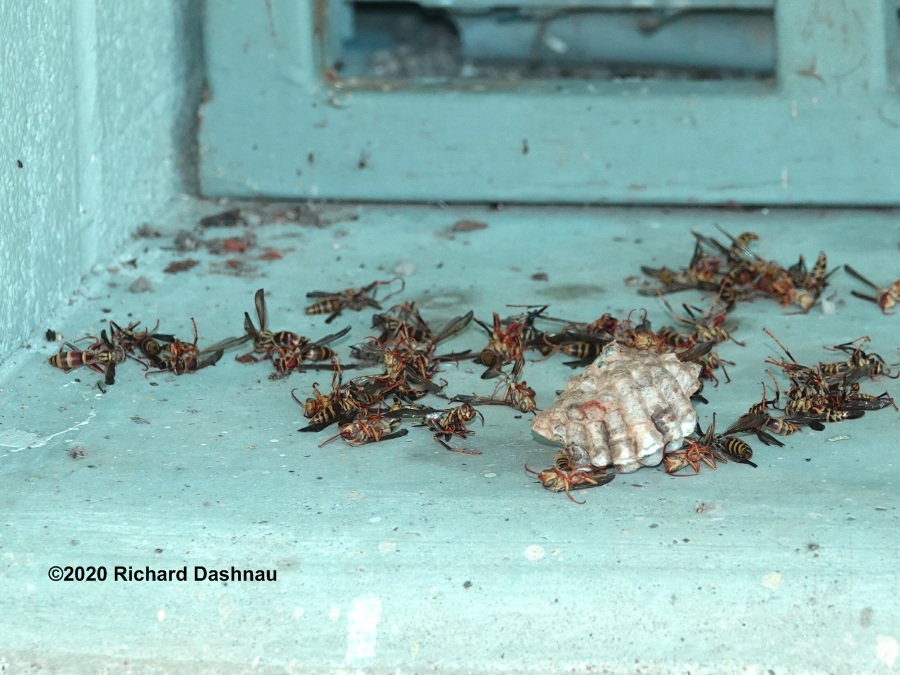
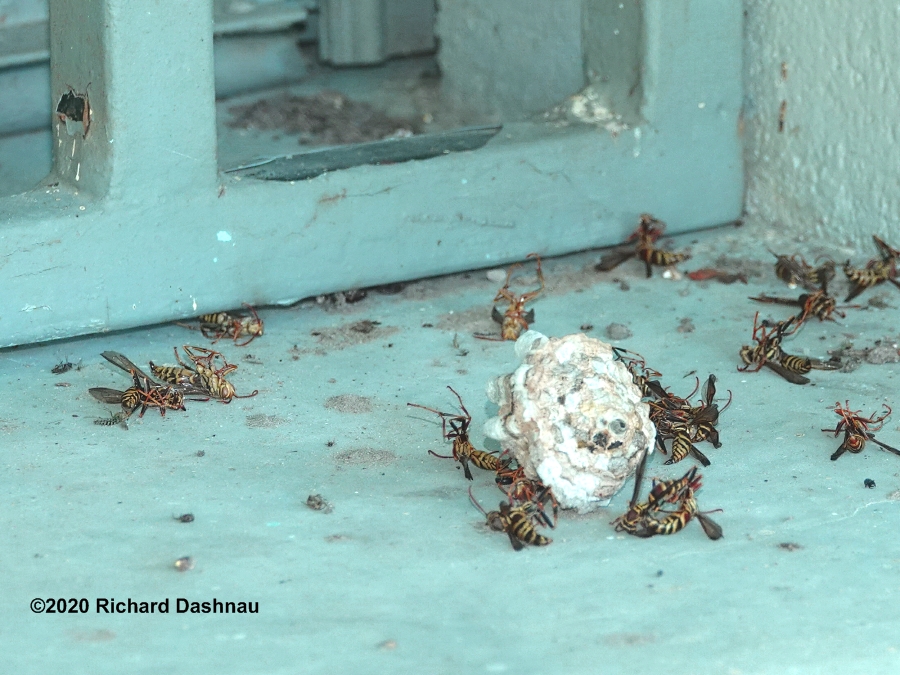
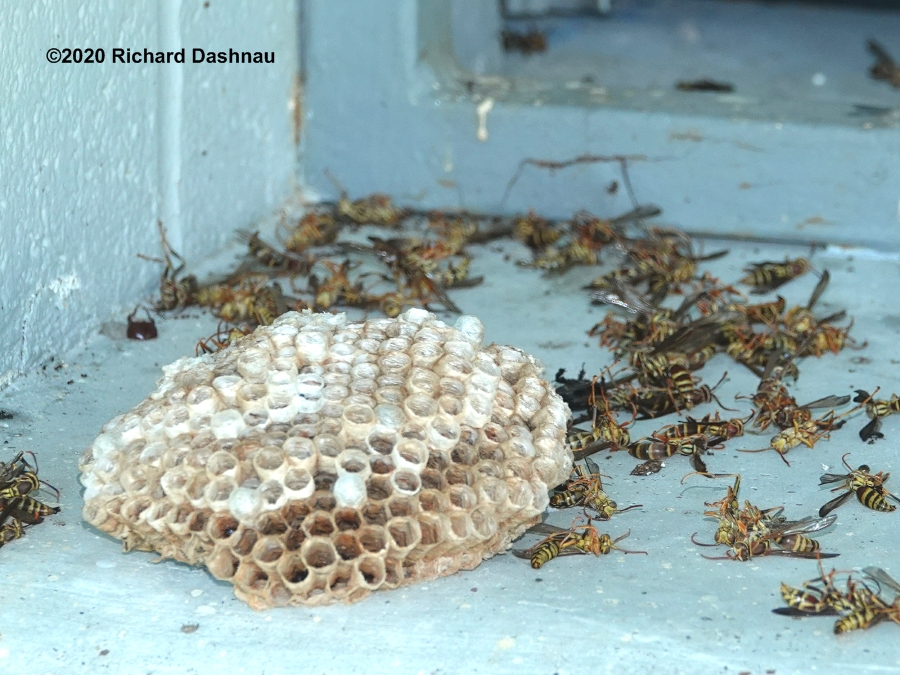
09/30/2018
A few weeks after I shot the first video, I was able to shoot more
video of the wasps. As before, I filmed while watching
through the
camera, and hoped to catch more interesting behavior. While
I was using the high speed function (hoping to catch a worker returning
with a food packet), I saw one of the wasps suddenly pull a larva out
of one of the cells--and then then begin eating it!
Although I
observed the act through the camera, I did not catch the precise moment
in the video. But, I filmed what happened after. The edited
video
shows a number of wasps (I cannot tell workers from
"gynes" or
males)
as they chew the larva apart. In the meantime, a worked does
return with a food packet, and a few other wasps began malaxating that
as well. I was surprised by seeing the
larva consumed, so I tried
to find
out what was going on. I read a number of items, including:
The Evolution of Social Wasps, by James H. Hunt;and Effect of food
availability on larval cannibalism by foundresses of the
paper wasp
Polistes
chinensis antennalis by K. Kudoˆ • A. Shirai.. I think I now
have some idea of what was happening. The images below are
from this short video clip
that shows what happened to the
larva, and some other
activities on the nest.
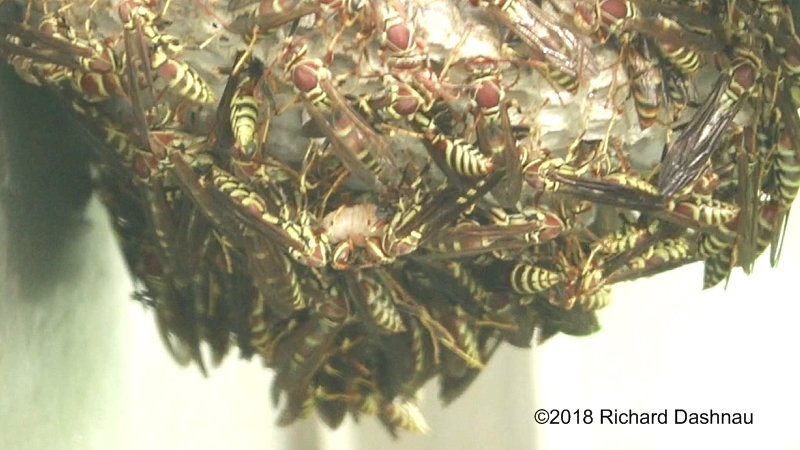
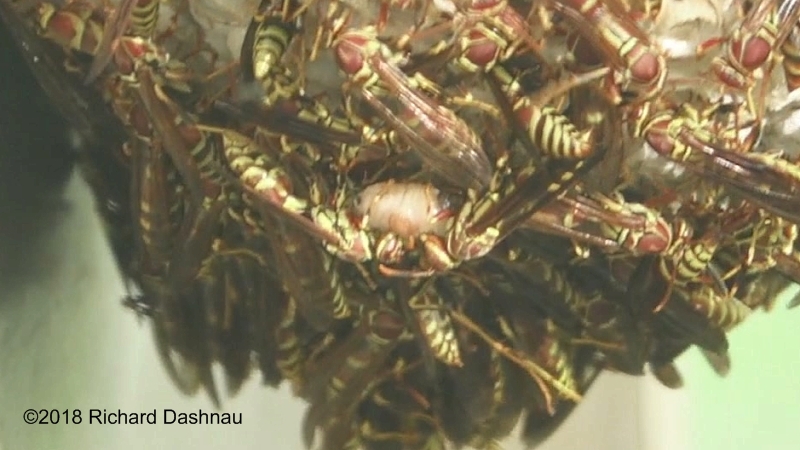
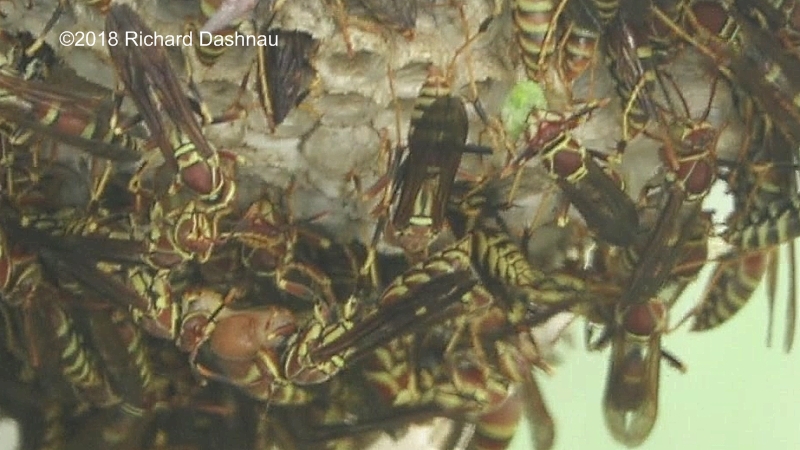
THE
LARVA IS IN THE CENTER
WORKERS CHEWING ON THE LARVA
ANOTHER WORKER ARRIVES WITH
FOOD
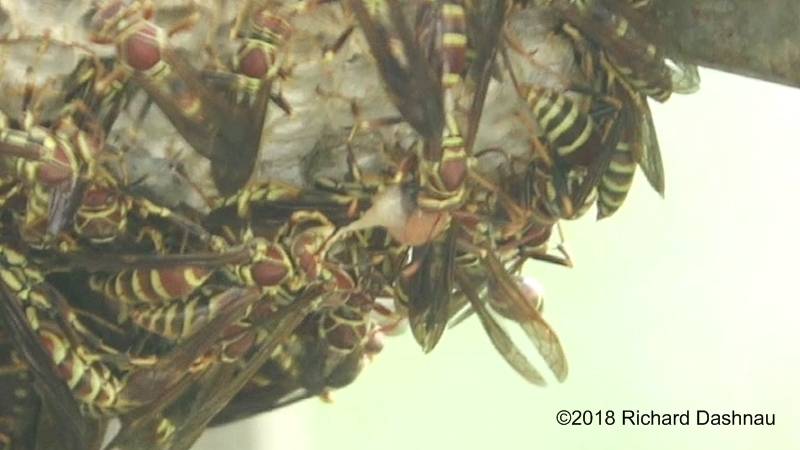
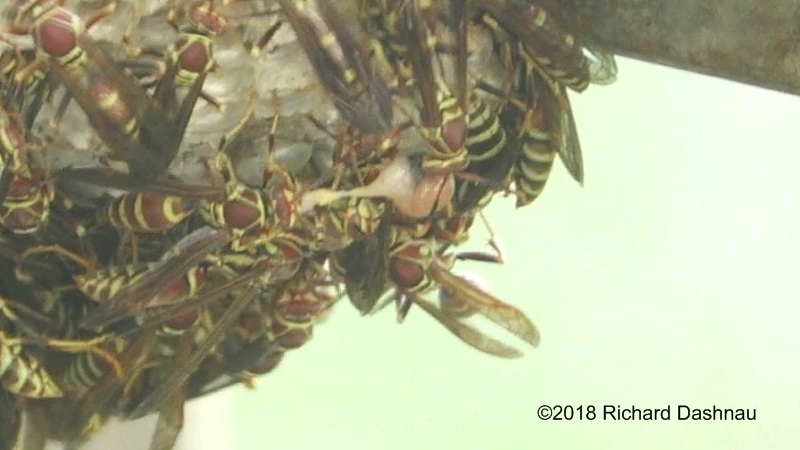
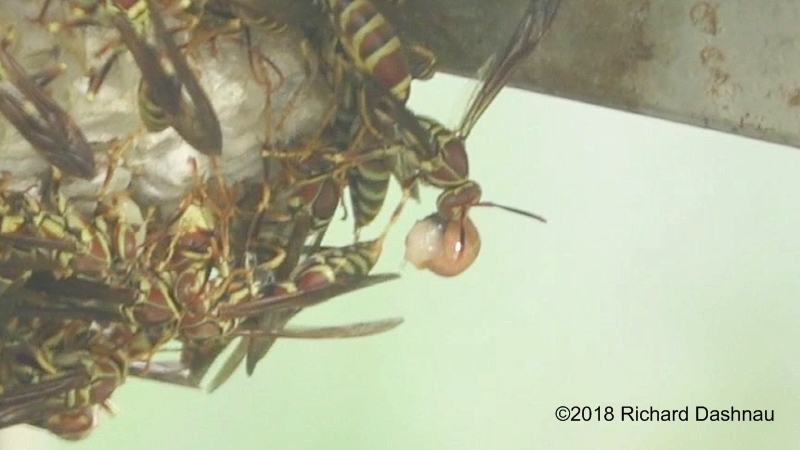
REMOVING
THE PERITROPHIC SAC?
TUG-OF-WAR WITH THE CARCASS
A WORKDER TAKING AWAY THE
WASTE
This
is a summary of what I've learned: A new queen, or
"foundress" starts
a nest with a few cells, then places an egg in each. Young larva are
fed liquids, including nectar and juices squeezed from prey.
Also, some
of her own newly-laid
eggs
are also fed to these larva. This is done to speed up the growth of
these critical first-hatched. The sooner they mature into workers, the
sooner the queen can stop risking her life foraging,
since
foraging will become the job of the workers. Older larvae are also fed
solid food--mostly caterpillars which have been kneaded (malaxated)
into pulp by worker wasps. Undigested solids or meconium are
stored in a sac ("peritrophic sac")
inside the larva throughout development. This waste is only expelled
once, when the larva cocoons, and collects in the closed end of the
cell. Over the season, the nest expands with
more cells--but will
stop eventually, and more eggs are deposited. Worker females forage for
nectar and also for caterpillars for provisioning the new larvae.
Sometimes, females will touch their antennae and
mouthparts to an
older larva (late instar) and the larva will secrete a "nutritious
saliva" which has nutrition value. Some sources postulate that this
exchange is partially to prevent
the workers from eating
the larva if foraging becomes difficult.
As fall approaches, the nest becomes crowded with workers,
and also
provisions become scarce as the seasons change. Also, since
they are
not being fed as much--and also
nearing "maturity" larger, older
larva can't produce as much of the "nutritious saliva" as before, and
may be cannibalized by workers.
...and that is what I witnessed.
Other workers began chewing on the larva. As they
progressed, I
noticed a large, dark organ being removed from the carcass. I believe
that was the peritrophic sac that contained the solid
waste, or
"meconium". This was eventually pulled free, and a worker
flew off
with it. During this time, a worked flew in with a wad of provision,
and another group of wasps worked on that. When I saw the
wasp
pull out the
larva, I was surprised--but now I know that this can
happen fairly often during the life of a wasp nest. The potential queen
(or queens)-which are called "gynes"-will find a place to shelter
through the winter. They
will begin
the cycle again next Spring, but the workers, and any males,
will die. I estimate that most of the wasps that I observed will be
dead in about a month. I thought this a bit sad, but also
could
appreciate how the workers were
a unique resource. The foundress
begins the nest, and immediately starts growing machines to support
that nest. These machines have a limited life span, but she is
constantly growing new ones. These machines do their
jobs through the
season, until they are no longer of any use. Then they are left to find
food for themselves (since there aren't any more larva to feed), and
eventually "run down" and die--and then become part of
the
environment as they biodegrade.
09/09/2018
There's a water-control structure at the end of one of the culverts in
the Elm Lake levee. One of the park visitors told me about some wasps
nesting there, so I went to examine it.
The
nest is exposed, but hanging on a structure only about 3 feet high.
Since the nest was obviously quite mature, it had probably
been
there for many weeks (I missed the entire month of August
since
I couldn't go out to BBSP). Therefore, I assumed it had been exposed in
that position for weeks (possibly months) and the wasps would be
relatively docile. I approached until I was about
10 feet away, and began documenting with photos and with
video. The image below is one of the
photos. I filmed
most of the video at 1920 x 1080 60FPS, at 25X optical zoom. I then
cropped the video
to
emphasize certain parts, so it seems I might have been much closer than
I actually was.
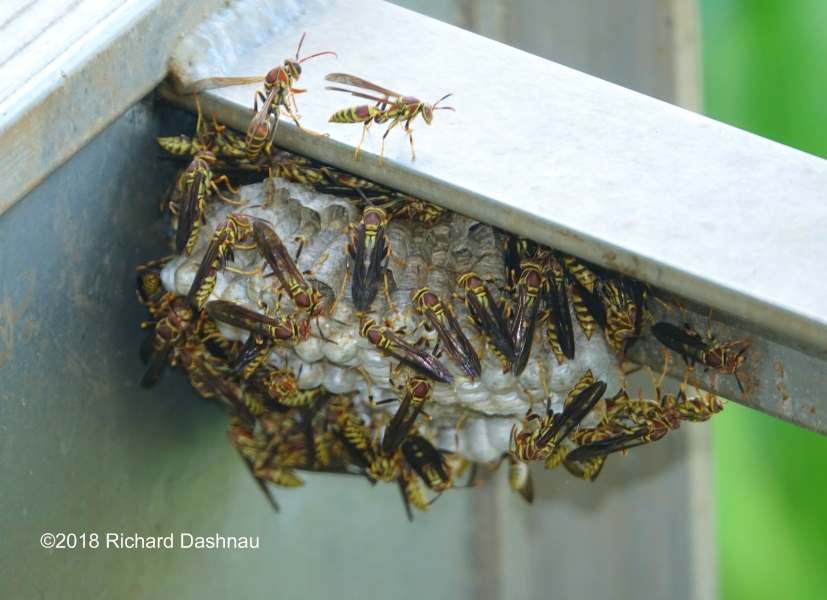
The
wasps are Paper Wasps, and in the family Polistes. The yellow stripes
on a brownish background probably identifies these as Polistes
exclamans. There was a lot of activity, so it was difficult to focus on
a particular
behavior.
But, I did notice when a wasp occasionally
returned to the nest with a bundle (which was usually green). I assumed
that the green bundles were the remains of caterpillars that the wasps
had found and harvested
by
removing the internal organs and other unsuitable parts for easy
transport. Paper wasps are generally viewed as "beneficial" because
they remove other insect pests such as caterpillars. The
images
below are
frames
from
the
video
which show a wasp returning with a parcel, and the other wasps
beginning to assist chewing it apart. Paper
wasps process their insect provisions (usually caterpillars, but other
insects are sometimes used)
by
kneading or "malaxating" the carcass and
pulling out solids and liquids. Solids are given directly to the
larvae, while liquids are stored in a "crop" and regurgitated later
to feed larvae. But, some of the liquid is also
used
by the adult wasps
for nutrition. I found some of this information in a paper titled:
"
ADULT NOURISHMENT DURING LARVAL PROVISIONING IN A PRIMITIVELY EUSOCIAL
WASP, POLISTES METRICUS SAY", by J. H. Hunt.
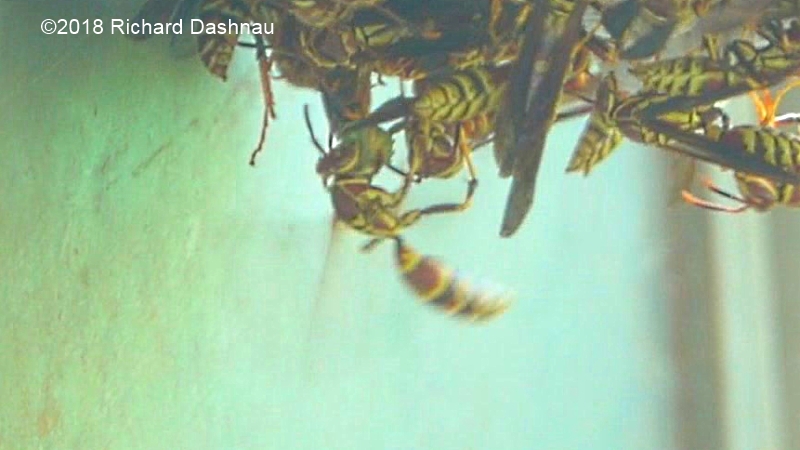
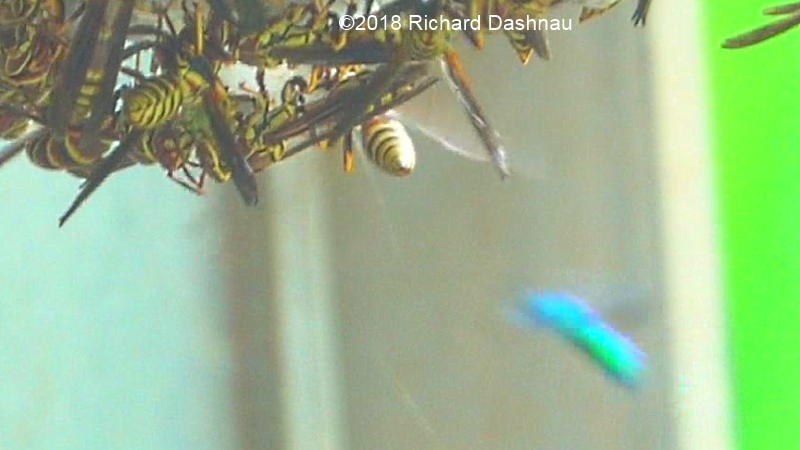
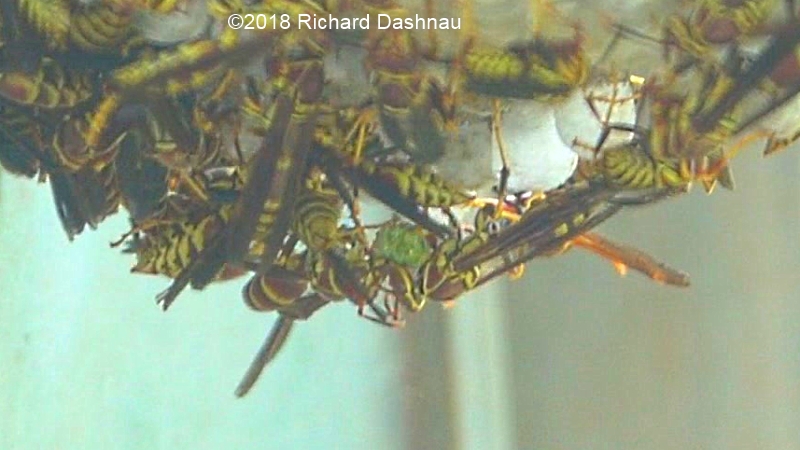
In
the middle frame grab, I show a blue-green blur in the background. I
believe the insect that was flying there was a cuckoo wasp, like the
one I mentioned loitering around the mud dauber nests. I don't think
the the
wasp's presence was an accident. I believe it intended to
parasitize the nest by infesting one or more cells with its own young.
The image below is a photo of that wasp. There are more images in
the video
clip...but
none that show the wasp clearly next to the nest clearly in a single
frame.
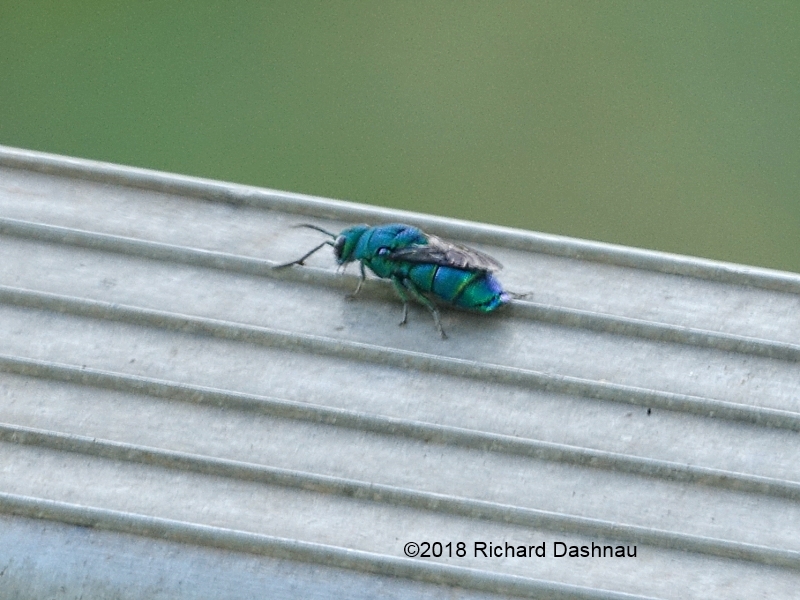
Left
alone, the nests of this species of wasp usually die in the fall--on
their own. Although not stated in the texts I read, one big reason is
probably they run out of food to feed to the larva. However,
the
wasps that will
become queens for the next generation (these are called
"gynes") will sometimes overwinter if they can find shelter.
I've
filmed more material at a later time. I'll be working on that soon.
Hopefully, I'll show one of the
other signs that a nest is nearing end-of-life for the season.
08/24/2014
That date is correct. This is something I saw in the summer of 2014. I
was walking along the West section 40 Acre Lake Trail. A tree
had
fallen down next to the lake, and as I passed it I noticed movement in
the
leave. I slowly moved closer, since I hadn't recognized the
movement, and didn't want to scare whatever it was. It was a
Paper
Wasp nest! As I watched, I saw the wasps gathered around the
nest, and then I saw some of them
start flapping their wings. The wasps
did not take off, but instead stood on the branches and the nest as
they beat their wings. I believe that the nest was exposed to direct
sunlight when the tree fell (the nest would have been
shaded while the
treee was standing normally); and the wasps were trying to fan
the nest
with their wings. I shot a picture and some video clips to show this
interesting behavior. The clips have been edited together and can
be
seen at this link.
Paper wasps usually make nests with exposed combs like
this--unlike hornets, which enclose their nests in a large envelope.
The bright yellow bands on these wasps help identify these
wasps
as Polistes exclamans.
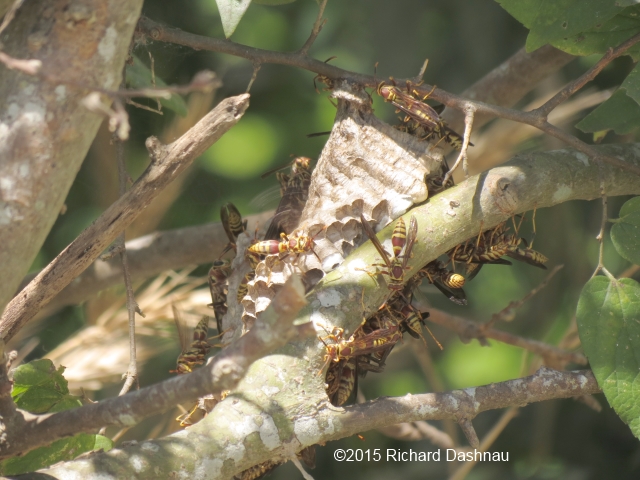
Go back to my home page, Welcome
to rickubis.com
Go
back to the RICKUBISCAM
page.
Go
back to the See
the World
page.